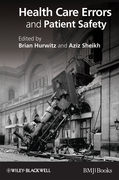
Over the past decade, a transformation in attitudes to health care error and patient safety has taken place. Recognition, classification, monitoring and prevention of errors have become visible fields of multidisciplinary debate, empirical research, and policy development, whereas 5 years ago such matters werelittle studied or discussed. Errors in medicine are now of great interest to many parties they attract the focus of lawyers, insurers and policy analysts, as well as the attention of medical educators, researchers, psychologists, professional, regulatory and defence bodies, patients and politicians. Each constituency brings different viewpoints to the issues raised by medical error, such as: error definition and reporting, error interpretation, how to identify the causes of medical error and maximise prevention, and how to reduce error associated health care harms. This volume presents a series of contributions by internationally recognized researchers, scientists and critical thinkers on medical errors, in order to chart the growing public and policy interest in medical fallibility and patient safety. It will be directed to a broad audience of practitioners, policy makers and researchers, and will encompass • the nature of medical fallibility and different approaches to defining error • relations between error and harm • what is known about the incidence and epidemiology oferrors and harms in different health settings and • strategies to minimise the occurrence of errors and their harmful consequences • interaction with the law: culpability for error, harm and bad luck • relevance to clinical appraisaland re-accreditation • the culture and ethos of clinical practices medical education and research.
- ISBN: 978-1-4051-4643-2
- Editorial: Wiley-Blackwell
- Encuadernacion: Cartoné
- Páginas: 288
- Fecha Publicación: 27/03/2009
- Nº Volúmenes: 1
- Idioma: Inglés
